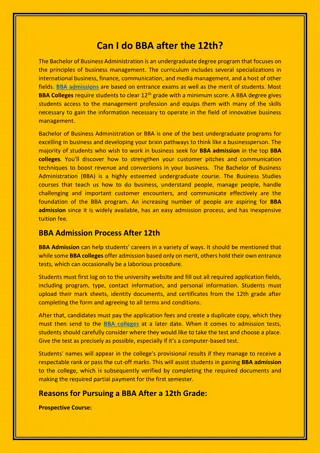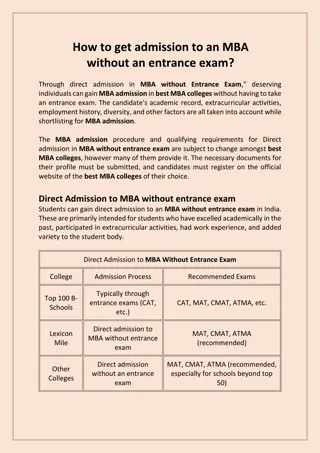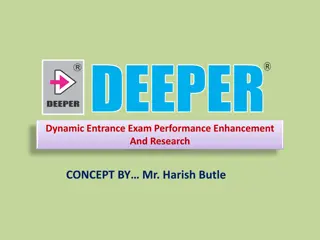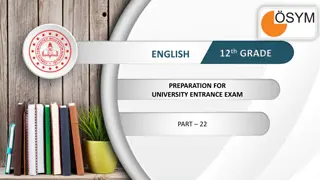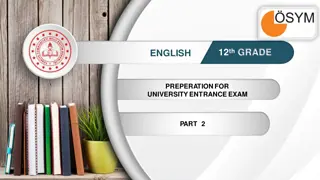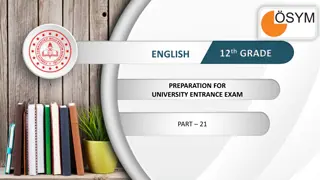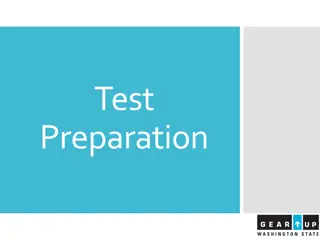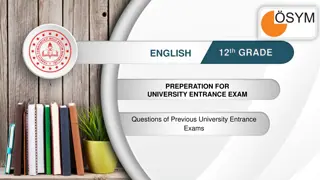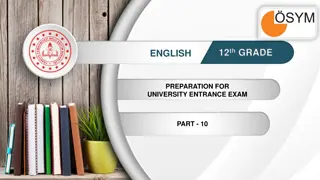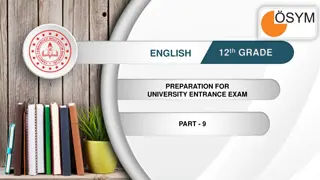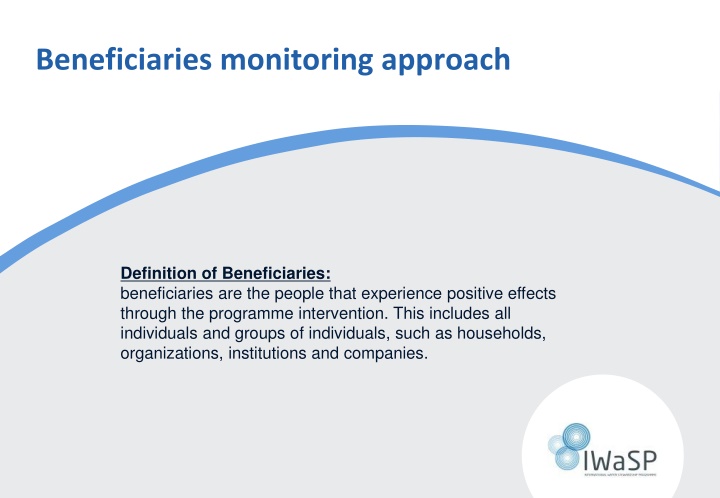
12th Grade English Preparation for University Entrance Exam - Part 5
Enhance your English skills with these challenging questions for 12th-grade level, focusing on grammar and comprehension. Prepare for university entrance exams with this advanced practice material.
Download Presentation

Please find below an Image/Link to download the presentation.
The content on the website is provided AS IS for your information and personal use only. It may not be sold, licensed, or shared on other websites without obtaining consent from the author. If you encounter any issues during the download, it is possible that the publisher has removed the file from their server.
You are allowed to download the files provided on this website for personal or commercial use, subject to the condition that they are used lawfully. All files are the property of their respective owners.
The content on the website is provided AS IS for your information and personal use only. It may not be sold, licensed, or shared on other websites without obtaining consent from the author.
E N D
Presentation Transcript
Beneficiaries monitoring approach Definition of Beneficiaries: beneficiaries are the people that experience positive effects through the programme intervention. This includes all individuals and groups of individuals, such as households, organizations, institutions and companies.
Content a. Results based monitoring approach b. The monitoring wheel c. The counting tool d. Examples e. Q&A section 2
A: Result based monitoring approach Beneficiaries could be counted through the following three levels of results : Outputs: immediate effects of activities Beneficiary: directly engaged in/targeted by activity (list with names required!) Outcomes: short and medium term effects of an output Beneficiary: those who experience change in their lives (proven by samples, counted by assumption based on census data no names required) 1. 2. Direct Impact: longer term Beneficiary: affected in the long run by the output; and/or through other changes stimulated through water security (counted on assumptions based on census data) 3. Indirect Example and how to avoid double counting: Input: A programme commits its human and financial resources in to protect a spring Activities: here training on how to protect the spring Output: increased knowledge in this area (trained people) Outcome: adjustment factors for assumptions A is: 50% (only 50% of the trained people will apply their knowledge not these people will be counted, the people benefiting from the effect of the applied knowledge of the 50%). Assumption A: person with knowledge will enforce protection. adjustment factors for assumptions B is: 20% (only 80% will share their knowledge) Assumption B. person with knowledge teaching other people why and how to protect springs. Effects: improvement of water quality and quantity for the connected people. Additional people with knowledge in this area. Impact: effect healthier population, increased productivity, etc. here every beneficiary counts, not matter if that person profit on output/outcome level before. Just if it benefited of the same effect by another intervention then it is not double counted. Discourse: Input: Resources put into activities: financial, human, technical, community and local resources Activities: using the resources/ what is done with the input: actions, processes, events, tools, meetings and trainings Output: delivered service or product/ immediate effect of the activity like: policy papers drafted, school build Outcome: Short/term & medium/term effect of an output Impact: The highest end result or impact. This is the change expected over the long term 3
A: Of the counted beneficiaries who will be reported The output and outcome beneficaires are reported on outcome level to Head quarter/management level. The impact beneficiaries on impact level. 4
A: Counting example Intervention A Intervention B Input Human and financial resources human and financial resources Activity Training awareness campaign Output Increased knowledge in this area (all beneficiaries of whom we have the names on lists - participated in the training are counted as direct beneficiaries) increased knowledge in this area (we do not count on output level people whose name we do not have) Outcome people practicing safer sex (direct beneficiaries - we do not need names), minus the ones we counted already on output level. They will spread the knowledge to family etc. They will practice safer sex and protect others etc. people practicing safer sex (direct beneficiaries - we do not need names) Impact healthier population with reduced HIV/AIDS and STD rates (indirect beneficiaries we do not need names) healthier population with reduced HIV/AIDS and STD rates (indirect beneficiaries we do not need names) How to count: When identifying output: use the beneficiaries excel tool to identify potential beneficiaries groups and disadvantaged groups Output: take baseline before activities start. Count beneficiaries by name Outcome: take baseline before activities start. Count beneficiaries by assumption, based on census and with on the situation depending adjustment factors (breach in a dike, etc.) Impact: Count beneficiaries by assumption based on census, with on the situation depending adjustment factors 5
A: Note on short, medium and long term effects sustainable comparable to long term effects. Short term and medium term effects do not mean that these effects are not in a short and, ideally, directly after the knowledge received , safer sex. The long term effect would be a healthier society. It is rather seen on a time scale/trigger effect. Example: people gaining the knowledge of how to practice safer sex, will start 6
A: Note on who will not be counted At current time disadvantaged groups will not be counted. This might be incorporated into the monitoring approach at a later stage. However, it is reflected in the excel tool to count beneficiaries. Disadvantaged: immediate and/or collateral interference of partnership measures with illegal and/or informal activities ultimately leads to their termination and economic/income losses of individuals and/or groups, hence by them the effects are perceived as predominantly negative (-); this might cause opposition to interventions while the project is running and/or afterwards. These can be e.g. farmers who are farming in riparian zones or informal vendors of water. BUT they will be identified and considered in order to plan intervention comprehensively and minimize rejection of intervention and prevent creation/escalation of conflicts, could be added here. It is also important to differentiate between people operating illegally and loosing out on the planned intervention and people operating legally and losing out on a planned intervention. Beneficiaries on output level without names are provided. Double counting: People who benefited on output level, will not be counted on outcome level. People who benefited on the same effect by another intervention will also not be counted. Note: people on impact level can be counted also if they benefited already on output or outcome level and also if they benefited on a different impact effect of course 7
B: The monitoring Wheel represents important annual milestones for the monitoring cycle Punctual: Evaluate outcome level when possible 15th January: Annual KPI reporting covering previous calendar year Continuous: Take baseline and monitor on output level Set assumptions on outcome and impact level Take monitoring samples of use of outputs Per partnership takes at least one baseline on outcome till impact level (with highest potential number for beneficiaries) Dec Jan February: Annual Strategy Workshop adjusting KPI targets Nov Feb Q3 Q4 Oct Mar 15th March: Investor/Sponsor reporting Sep Apr Q2 Q1 September: Annual Team Workshop discuss changes for annual monitoring round kick off of annual monitoring round Aug May The operational year runs from 1st April until 31st March. July June 8
C: Counting tool Please use the excel sheet beneficiaries tool to count your beneficiaries. The tool provides guidance and descriptions of the steps, and examples. 9
D: Example: Capacity building for agricultural water users to secure food supply 1. Activity: workshop/training 2. Output: immediate effects of activities Beneficiary: directly engaged in/targeted by activity Increased knowledge of the participants 3. Outcomes: short and medium term effects of an output Beneficiary: those who experience change in their life Farmers who got trained by the trained farmers People that benefit from better food supply through less risk of drought damaged harvest 4. Impact: longer term Beneficiary: impacted in the long run; and/or through other changes stimulated through water security People in the water catchment area that benefit from less water scarcity due to overall better water availability (this could mean that all people living in this catchment could be indirect beneficiaries. You will have to explain your decision on whom to count and based on the situation use your specific adjustment factor. 10
D: Examples: Construction of flood protection such as a dam/dike 1. Activity: constructing dam/dike 2. Outputs: immediate effects of activities Beneficiary: directly engaged in/targeted by activity People involved in construction 3. Outcomes: short and medium term effects of an output Beneficiary: those who also experience a positive change in water security People whose supply chain is depending on this area People whose lives, properties, activities are protected from future floods 4. Impact: longer term Beneficiary: impacted in the long run; and/or through other changes stimulated through water security People who benefit in the long run from better flood protection: all people in the wider area as it is more attractive to invest and live in. 11
D: Examples: Riparian Zone Protection Training 1. Activity: training 2. Outputs: immediate effects of activities Beneficiary: directly engaged in/targeted by activity Increased knowledge in this area 3. Outcomes: short and medium term effects of an output Beneficiary: those who also experience change in water security Trained people by instructed people People who take action to protect riparian zone. People who live in areas now (better) protected from seasonal flooding . 4. Impact: longer term Beneficiary: impacted in the long run; and/or through other changes stimulated through water security Water users further downstream who benefit from a (significant) increase of water quality. [assumption: flood protection is the main aim; water quality is only a bonus and thus indirect] 12
E: Q & A section Q How to identify specific effects and beneficiaries of improved ecosystems (e.g. improved water quality, safeguarded forests, increased awareness)? Which effects beyond the core objectives of the partnership should be considered by the country teams when selecting partnerships and co- operations, and deciding if to engage in a specific intervention? Which effects can be allotted to the partnership? The partnership members will identify measures to reduce water risks! This means each and every intervention has the main objective to reduce water risks, however the positive effects can occur in various fields. Thus we count all beneficiaries benefitting in one or the other form from our implemented interventions. A Activity: tree planting Output (direct) Outcome (direct) Impact (indirect) What is the immediate effect of the planted trees? What short/medium term effect do the trees have? What long term effect does the safeguarded forest have? Identify this and count beneficiaries of all the immediate effects. Identify effects and affected beneficiary groups. Identify all the effects and count beneficaries. A The prioritization of measures according to the number of beneficiaries might be obvious, but not trivial. You will have to take into account different weighting factors like protection of a Ramsar, UNESCO environmental side, protection of big infrastructure investments etc. which might influence your periodization matrix for measures. 13
Q & A section Q What to do with benefits not related to the partnership objectives like improved health, decreased expenditures and hazards (for stove as well as increased income (for artisans)? buyers) Activity: selling stoves (to avoid cutting of trees)! Output (direct) Outcome (direct) Impact (indirect) What is the immediate effect of the stoves? What short/medium term effect does selling of stoves have or the usage of stoves have? What long term effects does the usage of stoves and the selling of stoves have? Identify this and count beneficiaries of all the immediate effects Identify effects and affected beneficiary groups. Identify all the effects and count beneficaries A We look at the output produced, whether this is a service provided or a product and from that we look at immediate effects, short and medium effects as well as long term effects. The assumption is that the intervention is being implemented to improve water security, the effects however are multiple. Water security means what graph of UN water security definition. A 14
E: Chosen water security definitions Water Security definition The definition of water security is crucial for a partnership as it serves as the basis on how beneficiaries are defined. Currently, the concept is further refined and metrics are in the process of definition. They are to be defined on the basis of the different interventions the partnership will undertake. This definition will be put into relation with the concept of beneficiaries. Definition The concept of water security is defined on the basis of the UN definition of water security. The programme's concept addresses four main dimensions of water security: - Climate change hazards - Human well-being - Ecosystem - Economic Activities and Development These are embedded in Governance and Financing. Next to that above the relevant definitions of water security of the country a partnership operates in. Climate change-hazards This dimension represents the resilience of communities, companies and the public sector to face climate change related water risks. It further covers climate security. Human well-being Another important aspect of water security constitutes human well-being which covers the security of humans and communities as well as urban water security. Ecosystem A stable ecosystem is a further facet of water security. It has to be ensured that environmental needs are met and that the sustainability of measures is ensured. Economic Activities and Development Within the water security concept of a partnership also economic activities and development play a role. To attain viable water security energy security has to be considered as well. 15
E: Q & A section Q The partnership objective is to contribute water security in target catchments and to increase climate change adaptation and water resource management capacities of the respective stakeholders. The question after a project intervention by the partnership through the protection of the ecosystem / improvement of the water balance (e.g. siltation control, wetland conservation, decrease of pollution, groundwater recharge protection, afforestation): who are the beneficiaries? Activity: restoration of wetland Output (direct) Outcome (direct) Impact (indirect) What is the immediate effect of the wetland conserved? What short/medium term effect does the restored wetland has? What long term effects do the restored wetlands has? Identify this and count beneficiaries of all the immediate effects Identify effects and affected beneficiary groups. Identify all the effects and count beneficaries A You will have to look at all the single outputs you produced to achieve a improved water balance and from these single outputs you do your analyses of the effects on different result levels. You will have to measure the social, economic but also the physical effects of the restoration to be able to tell in which form the beneficiaries profited. A 16
E: Q & A section Q How to transparently limit the geographical range of influence of our interventions? A A A Measure how far the effect spreads in geographical terms? Please document the assumptions your decisions rely upon Use adjustment factors and explain why you used in this case an adjustment factor of x% Example: Assume that the improved water quality and qantity will have an effect on the whole catchment. It is a highly populated area and we know that many people for instance fetch their water in the neigberouing catchment. We also know that there are vendors transporting water from neigbouring catchments. Therefore the adjustment factor for the 100% of the population in the catchment would be by -25%, since a part of the population water source is external. 17
E: Q & A section Q Awareness raising and sensitisation: it is difficult to monitor and assess (operationalize and calculate) the effects, i.e. the influence on behavioral changes, of such activities, nonetheless they are crucial and core activities. This is a question of how to conduct the survey. People who have changed thanks the information received should be on outcome level and considered as direct beneficiaries. However, you will need to report this figure based on assumptions. Ideally a validation sample will be taken at a later stage. A Activity: conducting awareness campaign! Product: (awareness campaign conducted, posters, bill boards etc.)! Output (direct) Outcome (direct) Impact (indirect) What is the immediate effect of the awareness campaign? What short/medium term effect does the awareness campaign have? What long term effect does the safeguarded forest has? The immediate effect is the increased knowledge by the people listening, involved in the awareness campaign. However, as long as we do not have a list with names, beneficiaries on output level are not considered Only on Outcome level, when we do a sample and identify that the awareness campaign had an effect of people s behavior/life we count these beneficiaries on outcome level 18
E: Q & A section Q Where institutions like Water Resources Management Authority (WRMA), a Ministry or a county benefit through trainings / learning / implementation activity, then the staff members trained can be counted as direct beneficiaries; what about other colleagues in e.g. the same department (peer to peer learning)? And if this support enables an institution to fulfill its mandate (e.g. it is now capable of enforcing the pollution rules or improves its monitoring / data management system) who can be considered as (in-) direct beneficiaries? All direct, since the colleagues would be on outcome level. A Activity: training! Output (direct) Outcome (direct) Impact (indirect) What is the immediate effect of the training conducted? What short/medium term effect does the training have? What long term effect does the safeguarded forest have? The immediate effect is the increased knowledge by the people trained (participant list with names) Short/medium effects of the training could be that these trainers use their knowledge to train by peer to peer their colleagues. The colleagues would be beneficiaries on outcome level. Impact level is the long term effect of this intervention. 19
Q & A section Q The application of the water risks and opportunities assessment tool is part of the preparation / assessment phase. Can we already count beneficiaries here? Of course people involved in the assessment receive practical knowledge, if an event is organized to present the results, the participants receive info. Can these people / institutions / companies be considered as beneficiaries? If this is on output level, yes and also outcome level. It will increase their capacity to manage water risks A Activity: conducting water risk and opportunity assessment! Output (direct) Outcome (direct) Impact (indirect) What are the immediate effects of this product? Who benefits from this? What short/medium term effects of the water risk and opportunity assessment? if they are in a certain position/mandated and the participants use their gained knowledge to improve the situation in the catchment/ do certain measures or inform their colleagues this could be an outcome and affected people could be direct beneficiaries Upon documentation participants can be counted as beneficiaries. The immediate effects are the gaining of practical knowledge and information 20
E: Q & A section Q Contribution to other KPI: Relevance of achieving other indicators/KPIs: q.v. KEWASNET contributing to KPIs 20, 21, 22, 23; can this be considered as important reason to engage in a partnership or cooperation, even if the number of (in-) direct beneficiaries is comparatively small, and achievements may not be reached within the lifespan of the (initial) phase, e.g. a WRM policy on county and/or national level might not be implemented within 2 years? A This needs to be determined by your own country targets! If you have this target in 2 years time, then you might consider working on it already two years before to be able to achieve the target over time. 21






